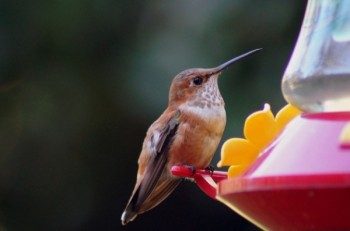Hummingbirds are some of the most fascinating and flashy fliers you’ll ever see. Yet they’re also some of the most misunderstood. If you want to attract them and keep them coming around (and don’t we all?) you might not be sure how to get started. After all, a lot of information is out there, and it’s a little overwhelming trying to decide what to believe or try. To provide a little insight into these tiny feathered gems, we thought we would get inside their heads a bit and think the way they do. Of course, we can’t really think like hummingbirds. But we have studied their behavior enough over the years to make some good guesses about what they’re thinking. Here’s what we think they might advise.
“USE RED! IT REALLY DOES WORK.”
In North America, the flowers best adapted for hummingbird pollination are bright red blooms with a tubular shape. Hummingbirds instinctively watch for red things and investigate them. (We’ve seen them making detours to check out the taillights of parked cars, and even someone’s sunburned nose!) There’s no question that planting red flowers will when attracting hummingbirds.
“WE DON’T NEED FANCY FOOD.”
Some companies sell hummingbird nectar, but you can easily make your own. Measure out 1 part white sugar to 4 parts water and mix thoroughly. If you boil the mixture to remove impurities, it may keep longer before it starts to spoil. And don’t mix in any honey, red dye or other additives when feeding hummingbirds. Simple sugar and water work just fine.

Feeding hummingbirds means keeping the feeders squeaky clean. Change the sugar water every few days and clean weekly.Cynthia Lockwood
“KEEP IT CLEAN.”
Sugar water that has started to grow moldy can be dangerous to birds. If you’re going to put out feeders, it’s essential that you keep them clean and replace the mixture regularly—at least once every three or four days, more often in hot weather. If the mixture starts to look cloudy, clean the feeder and replace the nectar immediately.
“PUT IT OUT IN THE OPEN.”
Hummingbirds are always looking around for food sources, and they’re good at finding them, but you’ll have more luck attracting hummingbirds if you put feeders in a place where it’s easy to spot. Use a feeder with some bright red on it, and position it where it can be seen by birds flying past at a distance.
“GIVE US A LITTLE EXTRA SPACE.”
Goldfinches and some other songbirds may feed together peacefully, but hummingbirds often fight around feeders, chasing one another away. Hummingbirds are adapted to feeding at flowers, which will produce only limited amounts of nectar, so they instinctively protect their food sources even when they’re at feeders with an unlimited supply. Try putting up two or more feeders that can’t be seen from one another. Even the toughest little hummingbird can’t monopolize multiple feeders if he or she can’t see them all at once.
“WE’RE CREATURES OF HABIT.”
If the hummingbirds returning in spring seem to remember where you had flowers or feeders in previous years, they probably do. As tiny creatures that rely on specialized food sources in a big, big world, they have to be good at finding their way back to the best spots. They have a highly developed sense of what scientists call spatial memory. This is a good reason to work extra hard at attracting hummingbirds. Once you get them established, they’ll be back for more.


